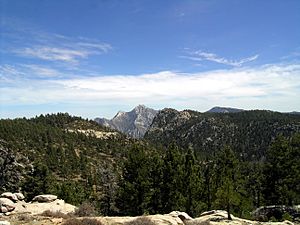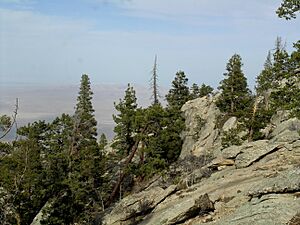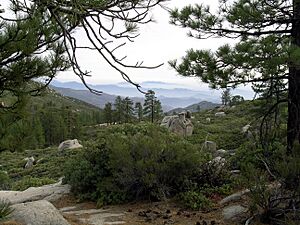Sierra de San Pedro Mártir facts for kids
The Sierra de San Pedro Mártir is a tall mountain range in Baja California, Mexico. In the Kiliwa language, its name means "mountains of Saint Peter the Martyr". This mountain range is a big part of the Peninsular Ranges System, which stretches all the way from Southern California down the Baja California Peninsula.

Contents
Geography of the Mountains
The highest point in the Sierra de San Pedro Mártir is a peak called Picacho del Diablo. It stands at about 3,096 meters (10,157 feet) tall. This makes it the tallest mountain in all of Baja California state and the entire Baja California Peninsula! People also call it Cerro de la Encantada (Enchanted Mountain).
These mountains act like a natural wall. They separate the rivers that flow west into the Pacific Ocean from those that flow east into the Gulf of California. In winter, the highest parts of the mountains often get snow.
To the north of this range are the Sierra de Juárez mountains. To the south, you'll find the Sierra de San Francisco. Both of these are also part of the larger Peninsular Ranges System.
Cool Features of the Sierra
Parque Nacional Sierra de San Pedro Mártir
The Parque Nacional Sierra de San Pedro Mártir is a special protected area within these mountains. It covers about 650 square kilometers (250 square miles). This national park was created in 1974. It was the first of two national parks to be set up on the Baja California Peninsula. The other park is Parque Nacional Constitución de 1857, located further north.
National Astronomical Observatory
High up in the Sierra de San Pedro Mártir, at about 2,830 meters (9,285 feet) above sea level, is the National Astronomical Observatory. This amazing place was built in 1975. It has several very large telescopes. The biggest one is 2.12 meters (83 inches) wide!
The observatory is built here for good reasons. The high elevation means the air is clearer. There are usually clear skies, low humidity, and not much pollution. There is also very little light pollution from cities, which helps astronomers see the stars better.
Plants and Animals
Flora: The Plants of the Mountains
The Sierra de San Pedro Mártir has many plants that are similar to those found in the Sierra de Juárez to the north. The higher parts of the mountains have Sierra Juarez and San Pedro Martir pine-oak forests. These are surrounded by California chaparral and woodlands at lower elevations. Even lower down, you find plants typical of the Baja California Desert.
Many of the plants here are also found in the Laguna Mountains and Cuyamaca Mountains in California. Common conifer trees include white fir, sugar pine, and Jeffrey pine. In the canyons on the eastern side of the mountains, you can find California fan palm trees. You might also see Arizona cypress growing with Canyon live oaks.

Fauna: The Animals of the Mountains
The Sierra de San Pedro Mártir is home to several interesting animals. The Baja California rainbow trout lives in the upper parts of the Rio Santo Domingo river. You can also find Desert bighorn sheep in these mountains.
One very special animal here is the California condor. These huge birds were once almost extinct. In 2002, condors bred in zoos (like the San Diego Zoo Safari Park) were released back into the Sierra San Pedro Mártir. This was the first time condors had been seen in the area since 1937! Each year, a small group of young condors from different zoos are chosen to be released into the wild here. This helps to bring these magnificent birds back from the brink.
See also
 In Spanish: Sierra de San Pedro Mártir para niños
In Spanish: Sierra de San Pedro Mártir para niños



